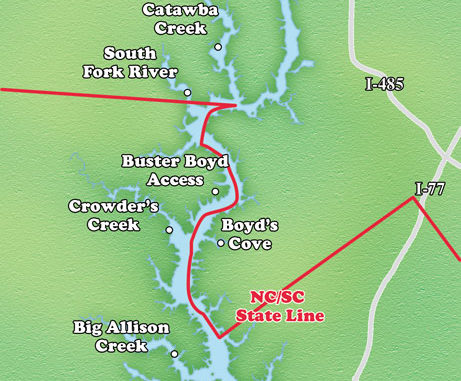
Two major techniques will help you catch your share of crappie this winter at Lake Wylie.
Crappie fishing at Lake Wylie during the winter usually gets off to a slow start, with fishermen waiting for that warm spell that usually shows up in February to get things stirred up.
But anglers who learn two different techniques should be prepared for everything the weather sends their way, from chilling cold to Indian summer.
Guide Jerry Neeley and Bill Shumaker, a veteran Lake Wylie fisherman, rely on fishing vertically around boat docks and brushpiles when the weather is at his coldest, switching to slow-trolling with multiple rods when a warm spell sets in.
“At this time of year, crappie may be pretty deep — 12 to 16 feet,” said Neeley, of Jerry’s Fishing Guide Service (704-678-1043). “A somewhat heavier jig will get down to the level where the crappie are.”
Neeley and Shumaker first look for schools of slabs on open-water structure: humps, ledges and channel drops. A good depthfinder helps, especially one with mapping or GPS functions that permit a fishermen to save as a “waypoint” previously located hotspots. Neeley searches for drop-offs in deeper water, noting that schools of crappie will show up on a depthfinder as large, mostly vertical “balls,” in part because, “On a bright day, the crappie will stack vertically,” he said.
A jig with a marabou or small, plastic tail, dropped along the deeper side of a sunken brushpile, is a very effective means of catching winter crappie at Wylie. When he finds deep-water crappie he casts, then lets the jig sink to the required depth.
“Once the jig has reached the depth you want, then just wind it up slowly,” said Neeley, who will occasionally tip a crappie jig with a live minnows. “Minnows work, particularly on cold days. Maybe the crappie are just not as active, but we do sometimes use minnows tipped on crappie jigs when we’re fishing vertically.”
Shumaker also fishes vertically over the same kinds of spots Neeley likes: deep-water brushpiles or drop-offs. He sticks with a Roadrunner, a small spinner/jig combination that comes with a marabou or plastic trailer — and once in a while, a minnow.
The other pattern Neeley relies on in cold weather is “shooting” boat docks and piers, a technique that is mostly underutilized by crappie fishermen.
Many of Lake Wylie’s docks and piers are close to the surface, some right above the water on flotation material. Crappie like to hide under the close-to-the-surface cover and are unlikely to chase a bait very far. Getting a bait back to them is a problem — at least until you get your “shooting eye.”
Shooting docks requires a limber rod, often as short as two or three feet. Longer, ultralight spinning rods also work, though they are somewhat less maneuverable. Light line, 2- to 4-pound test, is the best option because it is not as stiff as heavier line. Jigs, rather than minnows, are the prime lure selection. Some anglers use push-button reels while others rely on tiny spinning reels.
To shoot a dock, Neeley explained, a fishermen takes the jig between his thumb and forefinger and holds on, pulling the jig back until the rod is bent into a bow. With careful timing, the jig and line at the reel are released. The rod snaps forward and the jig shoots through a tiny opening, well back under a pier, where it is allowed to sink to the desired depth.
“Most docks provide at least some cover for crappie,” Neeley said. “Brush scattered about by lakeside homeowners, supporting poles of the docks, wide shade-producing surface of the docks. All those things hold crappie near the docks.
“When we shoot the docks, we use a 1/16th-ounce jig.”
Shumaker shoots docks with the smallest Roadrunner he can find, either an eighth- or a 1/16th-ounce model.
“They’re back there under the cover, and for the most part, no one ever fishes for them,” he said. “They just live a life of luxury there. Anglers don’t bother them. Herons can’t get at them. Shooting a Roadrunner or a jig is about the only way to reach those fish.
“Boathouses with doors are particularly good spots to shoot a Roadrunner. The door to the boathouse usually leaves a gap between the door and the water of less than a foot. As a result, the crappie under the boat house almost never see anything fake. So they are prime suspects.
“Positioning the boat in preparation for shooting is a key to success. To make a good cast, you need to be able to hold the rod parallel to the water, and as close to the dock as possible helps. If the boat is not in the right position, move it.”
Crappie might be in the thickest cover, but that shouldn’t deter a shooter from loading up.
“Don’t be afraid to shoot into some pretty heavy stuff — brushpiles under a pier, that sort of thing,” he said. “Jigs are pretty cheap, and if you lose a couple, it’s no big deal. Try the difficult shots. It may be that you can reach fish overlooked by every other angler on the lake.
“And don’t overlook isolated boat docks or piers,” Shumaker said. “From the crappies’ perspective, the boat dock sitting all by itself may be the only cover around.”
As the water warms, Neely relies on trolling as a preferred means of catching Lake Wylie crappie.
“Trolling is the way we catch most of the big crappie,” he said. “We often catch 10 or 20 a day between a pound-and-a-half and two pounds. And trolling is how we catch (bigger fish).”
Trolling is particularly effective on cloudy days, according to Neely.
“On cloudy days, the crappie at Lake Wylie are scattered,” he said. “Trolling is a better way to locate scattered fish, because you can cover so much more water in a shorter period of time.
“What I do is mostly what I call flat-line trolling, just letting the jigs drag out behind the boat. Once the water reaches 50 degrees, I switch to 1/32nd-ounce jigs. As a rule, I don’t use minnows much when trolling.”
Neely rigs his boat with 10- and 12-foot rods mated with reels spooled with 6-pound test line. The longer rods extend the reach of the trolled jigs beyond the reach of the shorter rods. He puts two rods on the sides of the boat and additional rods out the back. On the rear of the boat, Neely uses 10-foot rods. He’ll stagger the distance that jigs swim behind the boat.
“The crappie will tell you when you’ve got it right. On the rods out the sides, I let the jigs drop back a ways. Right behind the boat, the distance of those jigs from the boat is about 25 feet,” Neeley said. “Pretty soon, some rods with the selected distances will be catching fish and the others will not.”
To some extent, the farther behind the boat the jigs are trolled, the deeper they will run. In any event, Neely said, “The crappie will tell you when you’ve got it right.”
With his GPS, Neeley can make sure he trolls at the correct speed.
“I troll at nine-tenths of a mile per hour. I watch the GPS and I stick to that speed,” he said.
When it comes to jigging vertically or trolling, Shumaker and Neeley have some color preferences.
“Lots of colors work. My best bets are chartreuse, yellow, pink and John Deere green,” Neeley said. “I really like green at Lake Wylie — and I often mix in some white.”
Shumaker checks with other fishermen to see what the hot colors are at any time, although his usually uses a white Roadrunner and trailer with a silver blade.

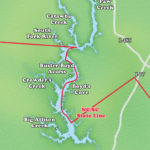
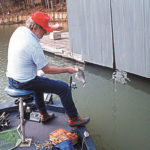
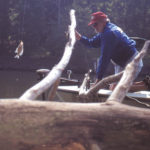
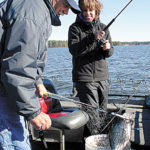
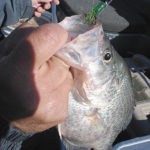
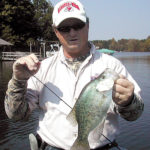


Be the first to comment